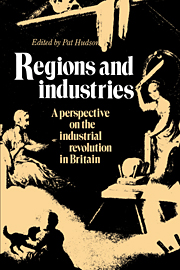Book contents
- Frontmatter
- Contents
- List of figures
- List of maps
- List of tables
- List of contributors
- Acknowledgements
- Introduction
- 1 The regional perspective
- PART ONE THE TEXTILE HEARTLANDS OF THE INDUSTRIAL REVOLUTION
- 2 Proto-industrialisation and the first industrial revolution: the case of Lancashire
- 3 Capital and credit in the West Riding wool textile industry c. 1750–1850
- PART TWO OTHER PATHS, OTHER PATTERNS
- PART THREE THE DIVERSE NATURE OF THE OUTER REGIONS
- Index
2 - Proto-industrialisation and the first industrial revolution: the case of Lancashire
from PART ONE - THE TEXTILE HEARTLANDS OF THE INDUSTRIAL REVOLUTION
Published online by Cambridge University Press: 05 May 2010
- Frontmatter
- Contents
- List of figures
- List of maps
- List of tables
- List of contributors
- Acknowledgements
- Introduction
- 1 The regional perspective
- PART ONE THE TEXTILE HEARTLANDS OF THE INDUSTRIAL REVOLUTION
- 2 Proto-industrialisation and the first industrial revolution: the case of Lancashire
- 3 Capital and credit in the West Riding wool textile industry c. 1750–1850
- PART TWO OTHER PATHS, OTHER PATTERNS
- PART THREE THE DIVERSE NATURE OF THE OUTER REGIONS
- Index
Summary
In the last few years the literature on proto-industrialisation has almost achieved its own take-off into self-sustaining growth. The theories and agenda advanced by the pioneers of the concept have been applied to regions and economies far removed from its original settings in north-western and central Europe. Russia and Japan now feature in the proto-industrial canon, and the concept has also migrated from country to town, with studies of urban proto-industrialisation in settings as economically and geographically diverse as Lisburn (Northern Ireland) and Bologna. But, surprisingly, nothing has yet been said about the applicability of the theories to the Lancashire textile industries. This is extraordinary because south-east Lancashire, especially, has a strong claim to having become the first full-fledged industrial society during roughly the last quarter of the eighteenth century and the first half of the nineteenth. At any rate, it combined factory industry, using steam power, continuous operation and a high level of mechanisation, with the rapid rise of distinctively industrial towns on an ever-growing scale, and the emergence of the first concentrated, purely industrial proletariat. Whatever qualifications one might want to make about the persistence of older ways of working alongside the factory, this was a remarkable set of developments. If a transition from pre-industrial through proto-industrial to industrial economy and society took place anywhere in its pure form, uncontaminated by the influence of prior innovations elsewhere, it should have been in the Manchester area of Lancashire.
- Type
- Chapter
- Information
- Regions and IndustriesA Perspective on the Industrial Revolution in Britain, pp. 41 - 68Publisher: Cambridge University PressPrint publication year: 1989
- 7
- Cited by

